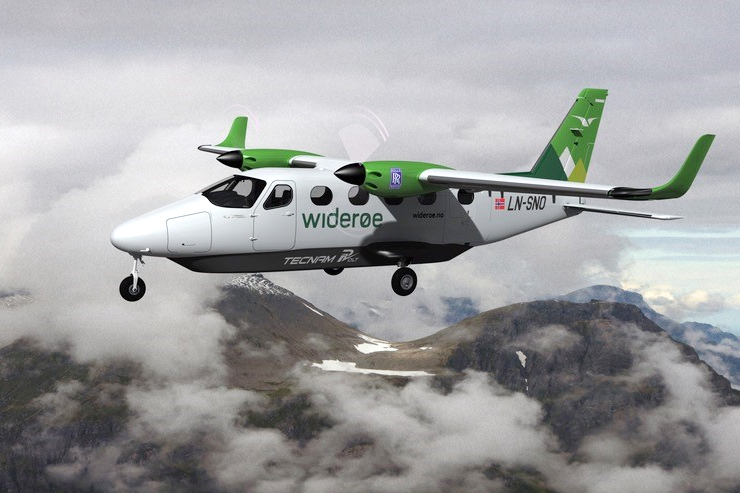Widerøe: Pioneering Electric Aviation in Norway

Widerøe, a prominent regional airline in Norway, is making significant strides in the realm of electric aviation. Known for its long-standing commitment to connecting remote areas of Norway, Widerøe has a rich history dating back to 1934 when it was founded by a pilot. The airline, which operates a fleet of 40 Dash-8 turboprop aircraft and three Embraer E190-E2 jets, became a symbol of resilience during the pandemic. At one point, it even held the title of Europe’s largest airline due to the necessity of domestic flights in Norway. Today, Widerøe stands as a pioneer in the field of electric aviation, with plans to introduce scheduled all-electric flights by 2026.
Widerøe’s Remarkable Journey
Widerøe Airlines is deeply ingrained in the fabric of Norway. Since its inception, the airline’s mission has been to bridge the geographical challenges presented by Norway’s rugged terrain. The country’s vast expanse is characterized by deep fjords and snow-capped mountains, making aviation a lifeline for remote communities. With a fleet comprising mostly regional aircraft, Widerøe plays a vital role in ensuring that even the most isolated corners of Norway remain connected.
During the global pandemic, when domestic flights in Norway were a lifeline for many, Widerøe rose to prominence. The airline carried around 2.5 million passengers, connecting 45 airports in Norway and a few European destinations. Its strategic importance during the pandemic showcased its resilience and adaptability.
Pioneering Electric Flying
Widerøe is well on its way to becoming a frontrunner in scheduled all-electric flights, setting the stage for a groundbreaking shift in aviation. The airline’s ambitious journey towards electric aviation is underpinned by its subsidiary, Widerøe Zero, a think tank dedicated to sustainable flying. Andreas Kollbye Aks, Widerøe’s Chief Strategist and head of Widerøe Zero, emphasizes the importance of pushing the boundaries in aviation technology. He acknowledges the significant challenges of leading the industry with new technologies but remains committed to driving innovation in the market.
Norway: The Ideal Ground for Electric Aviation
The geography of Norway provides an ideal foundation for the world premiere of electric aviation. With its expansive territory stretching from the North Cape, the northernmost point of Europe, to the southwestern region, the country boasts a unique topography for testing electric aircraft. The vast coastline, which extends over 2,650 kilometers, coupled with numerous fjords and bays, creates an aviation-dependent landscape.
According to Jonas Kristiansen Nøland, a scientist at the Norwegian University of Science and Technology (NTNU), Norway’s geographic layout is perfectly suited for short-haul routes. Most of the population, approximately 80 percent of Norway’s 5.5 million people, reside in cities in the southern regions. In contrast, remote settlements are scattered throughout the vast northern expanses. Aviation is not just a convenience but a necessity for connecting these isolated communities.
Moreover, Norway’s commitment to sustainable energy sources, particularly hydro and wind power, ensures the availability of clean energy crucial for electric aviation. While electric flying still faces challenges, including limited battery capacity and range, the Norwegian landscape is forgiving. The dramatic fjords and proximity of key cities present opportunities for short-haul electric flights.
Potential Inaugural Route: Bergen to Stavanger
One of the routes at the forefront of electric aviation initiatives is the connection between Bergen and Stavanger, two key cities in western Norway. Although they are merely 160 kilometers apart, deep fjords separate them, making air travel the most efficient option. Currently, this route accommodates around 550,000 passengers annually, underscoring its significance.
A Pioneering Nation
Norway’s state-run airport operator and air traffic control provider, Avinor, is leading the country’s charge towards electric aviation. In 2020, Norway set ambitious goals to become a global leader in electric aviation. Avinor aims to make electric aircraft a substantial part of the market, with the objective of electrifying all domestic flights within Norway by 2040.
Widerøe’s Strategic Partnerships
Widerøe is not embarking on its electric aviation journey alone. The airline has established vital partnerships to support its electric aircraft initiatives. Since 2019, Widerøe has been in a strategic partnership with Rolls-Royce. This collaboration has extended to include Tecnam, an Italian manufacturer of nine-seat commuter aircraft. In addition, Widerøe has a partnership with Embraer for larger aircraft projects.
The Initial Step: Tecnam P-Volt
The first phase of Widerøe’s electric aviation journey involves the electrification of the Tecnam P2012 Traveller, a nine-seat piston-engine aircraft that has been in service since 2019. This aircraft, which is known for its versatility and performance, is being transformed into the Tecnam P-Volt. Widerøe has signed a letter of intent to purchase a yet-to-be-disclosed number of P-Volt aircraft.
The Tecnam P-Volt is expected to have a range of approximately 85 nautical miles, including a 30-minute energy reserve. This range makes it well-suited for the proposed Bergen-to-Stavanger route. The electric propulsion system for the P-Volt has been developed by Rolls-Royce and boasts an impressive output of about 500 kilowatts.
Widerøe’s commitment to electric aviation is ambitious, with plans to introduce all-electric short-haul regional flights by 2026. This timeline, though challenging, underscores the airline’s determination to lead the industry in sustainable flying. While technical aspects are crucial, Widerøe recognizes the need for certification of processes and procedures for operating electric aircraft.
Widerøe’s pioneering efforts in electric aviation offer a glimpse into the future of sustainable flying. Norway, with its unique geography and commitment to clean energy, is an ideal testing ground for electric aircraft. As Widerøe and its partners work towards electrifying the skies, the world watches with anticipation. If Norway can successfully transition to electric aviation, it could set a precedent for the entire industry. The challenges are significant, but the collective effort and aligned objectives in Norway provide a beacon of hope for a greener future in aviation.





